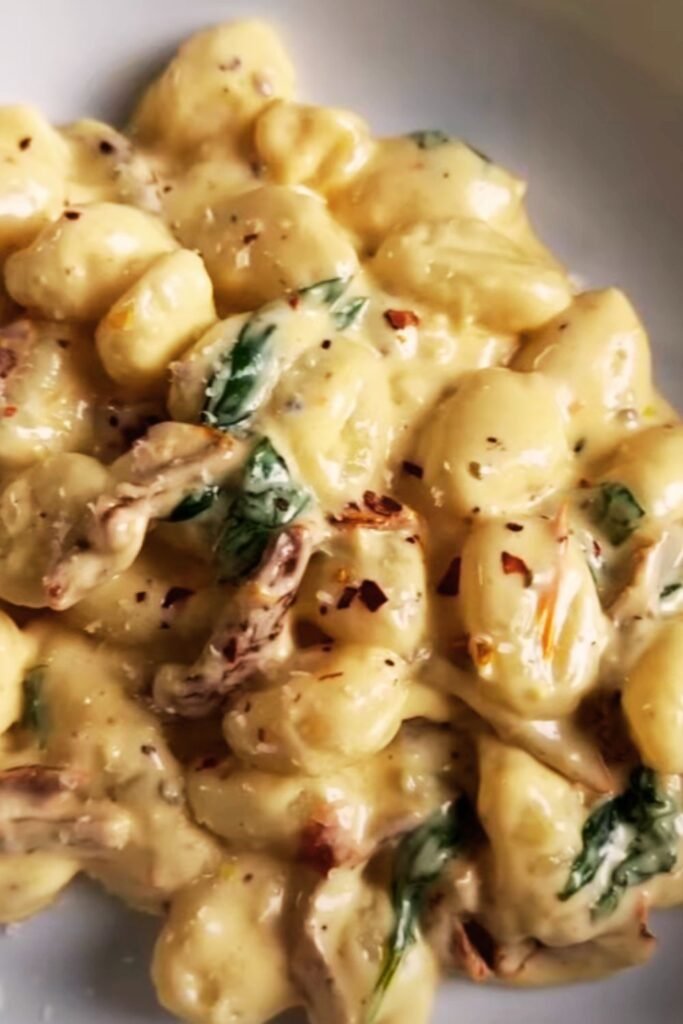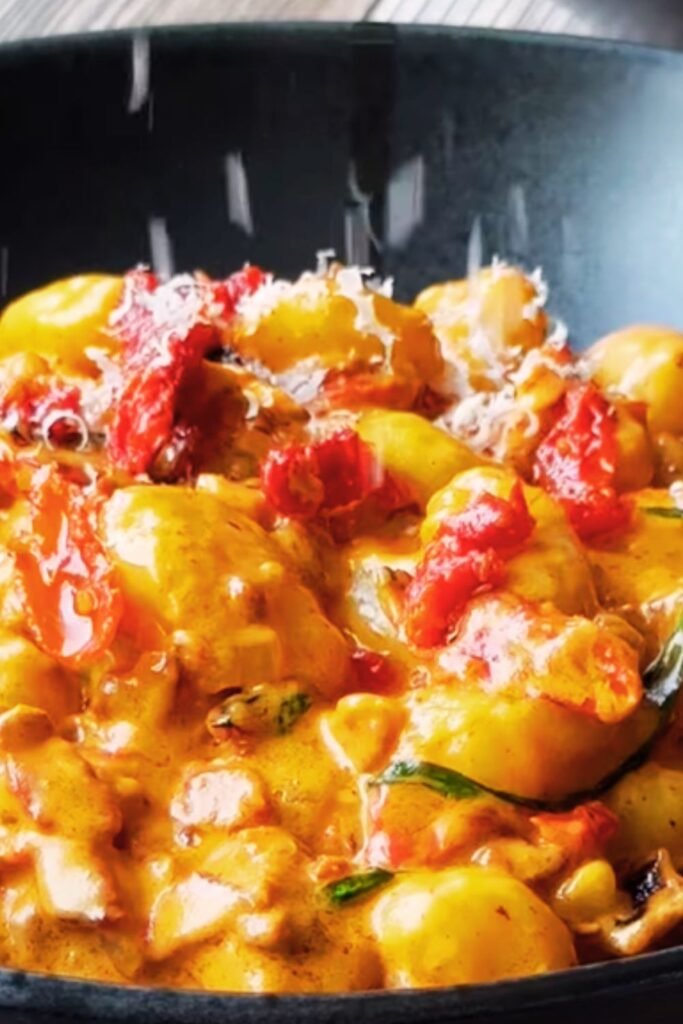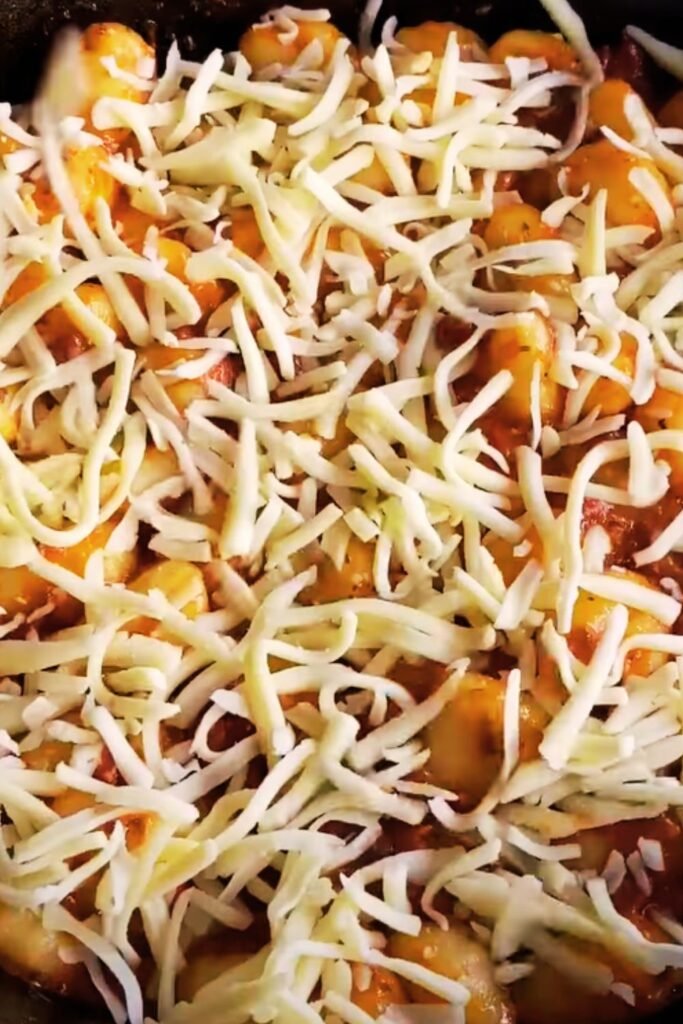There’s something magical about the way pillowy gnocchi absorbs creamy sauce, especially when paired with the intense, concentrated flavor of sun-dried tomatoes. I’ve been perfecting this recipe for years, and I can honestly say it’s become one of my most requested dishes at dinner parties. The combination of tender potato dumplings swimming in a rich, velvety sauce dotted with chewy, tangy sun-dried tomatoes creates a symphony of textures and flavors that never fails to impress.
What makes this dish particularly special is how it transforms simple ingredients into something that tastes like it came from an upscale Italian restaurant. The sun-dried tomatoes bring an incredible depth of flavor – they’re like little bursts of concentrated summer sunshine that elevate the entire dish. When I first discovered this combination, I was amazed at how the sweetness of the cream sauce balanced perfectly with the intense tomato flavor.
Understanding Gnocchi: The Foundation of Great Italian Comfort Food
Gnocchi – Small Italian dumplings typically made from potatoes, flour, and eggs, known for their pillowy texture and ability to absorb flavors beautifully.
Sun-Dried Tomatoes – Tomatoes that have been dehydrated to remove most of their water content, concentrating their flavor into intense, chewy morsels with a sweet-tart taste profile.
Cream Reduction – The process of simmering cream-based sauces to thicken them naturally while intensifying flavors through evaporation.
The beauty of gnocchi lies in its versatility and comfort factor. These little potato pillows have been gracing Italian tables for centuries, and for good reason. They’re substantial enough to serve as a main course, yet delicate enough to let accompanying flavors shine through. When I’m teaching cooking classes, I always emphasize that good gnocchi should be light and fluffy, not dense or gummy.
Essential Ingredients and Their Roles
| Ingredient | Quantity | Purpose | Selection Tips |
|---|---|---|---|
| Fresh Gnocchi | 1.5 lbs | Main starch component | Look for pillowy texture, avoid overly dense varieties |
| Heavy Cream | 1 cup | Creates rich, velvety sauce base | Use 35-40% fat content for best results |
| Sun-Dried Tomatoes | 3/4 cup (oil-packed) | Provides intense flavor and chewy texture | Oil-packed varieties are more tender than dry |
| Garlic | 4 cloves | Aromatic foundation | Fresh garlic minced fine works best |
| Parmesan Cheese | 1 cup (freshly grated) | Adds nutty, salty depth | Parmigiano-Reggiano provides superior flavor |
| Fresh Basil | 1/2 cup (chopped) | Bright, fresh contrast | Look for vibrant green leaves without dark spots |
| White Wine | 1/2 cup | Deglazing and flavor enhancement | Dry varieties like Pinot Grigio work well |
| Butter | 3 tablespoons | Richness and glossy finish | European-style butter has higher fat content |
Step-by-Step Preparation Method
My approach to this dish focuses on building layers of flavor while maintaining the delicate texture of the gnocchi. Here’s how I create this restaurant-quality meal:
Preparation Phase:
- Bring a large pot of salted water to boil for the gnocchi
- Drain sun-dried tomatoes, reserving 2 tablespoons of oil
- Mince garlic finely to ensure even distribution
- Grate Parmesan cheese fresh for optimal melting
- Chop basil just before use to maintain bright color
Cooking the Gnocchi: I always start with the gnocchi because timing is crucial. Fresh gnocchi cooks incredibly quickly – usually just 2-3 minutes until they float to the surface. Overcooking results in mushy, unappetizing dumplings that fall apart in the sauce. I use generously salted water (it should taste like seawater) because this is the only opportunity to season the gnocchi directly.
Building the Sauce Foundation: In a large skillet, I heat the reserved sun-dried tomato oil over medium heat. This oil is liquid gold – it’s already infused with concentrated tomato flavor. I add the minced garlic and sauté until fragrant, about 30 seconds. The key here is not to let the garlic brown, as it becomes bitter.

Deglazing and Cream Addition: Adding white wine at this stage serves multiple purposes. It deglazes the pan, picking up any flavorful bits, and the alcohol cooks off, leaving behind a subtle acidity that balances the richness to come. After the wine reduces by half, I pour in the heavy cream.
The Cream Reduction Technique: This is where patience pays off. I simmer the cream gently, allowing it to reduce and thicken naturally. The sauce is ready when it coats the back of a spoon. This usually takes 8-10 minutes of gentle simmering. Rushing this step by using high heat will cause the cream to break or curdle.
Mastering the Sun-Dried Tomato Integration
| Integration Method | Timing | Result | Why It Works |
|---|---|---|---|
| Early Addition | With garlic | Deeper flavor infusion | Allows tomatoes to rehydrate and release oils |
| Mid-Process | After wine reduction | Balanced integration | Prevents overcooking while ensuring flavor distribution |
| Final Garnish | Just before serving | Textural contrast | Maintains distinct tomato pieces for visual appeal |
I prefer the mid-process addition because it strikes the perfect balance. The sun-dried tomatoes have time to soften slightly in the warm sauce while maintaining their distinctive chewy texture. They release their concentrated flavors into the cream without becoming mushy.
The Perfect Gnocchi-to-Sauce Ratio
Getting the proportions right is crucial for this dish. Too much sauce and the gnocchi drowns; too little and it becomes dry and unappetizing. Through years of experimentation, I’ve found that 1.5 pounds of gnocchi pairs perfectly with about 1.5 cups of finished sauce. This ratio ensures each piece of gnocchi gets properly coated while maintaining the right consistency.
When combining the gnocchi with the sauce, I use a gentle folding motion rather than aggressive stirring. Gnocchi are delicate, and rough handling can cause them to break apart. I add the drained gnocchi directly to the simmering sauce and fold gently with a large spoon or spatula.

Cheese Integration and Finishing Touches
The Parmesan cheese serves as both a flavor enhancer and a natural thickening agent. I remove the pan from heat before adding the cheese to prevent it from becoming stringy or clumping. The residual heat is sufficient to melt the cheese smoothly into the sauce.
Fresh basil goes in at the very end – its bright, aromatic oils are volatile and dissipate quickly when exposed to heat. I save some for garnish because the visual contrast of vibrant green against the creamy white sauce dotted with ruby-red tomatoes is simply stunning.
Nutritional Profile and Dietary Considerations
| Nutrient | Per Serving (6 servings) | Daily Value % | Health Benefits |
|---|---|---|---|
| Calories | 485 | 24% | Substantial energy source |
| Protein | 18g | 36% | Muscle maintenance and satiety |
| Carbohydrates | 52g | 17% | Primary energy source |
| Fat | 24g | 37% | Essential fatty acids and flavor |
| Calcium | 320mg | 32% | Bone health support |
| Vitamin C | 15mg | 17% | Immune system support |
| Iron | 3.2mg | 18% | Oxygen transport |
While this is certainly a rich, indulgent dish, it provides substantial nutritional value. The sun-dried tomatoes contribute lycopene, a powerful antioxidant, while the cheese provides calcium and protein. I often serve smaller portions as a first course or pair it with a crisp salad to balance the richness.
Serving Suggestions and Presentation
The presentation of this dish can elevate it from a simple pasta meal to an elegant dinner party centerpiece. I prefer serving it in warm, shallow bowls that showcase the beautiful colors and textures. A sprinkle of additional Parmesan and a few fresh basil leaves make for an attractive garnish.
Complementary Side Dishes:
- Arugula salad with lemon vinaigrette cuts through the richness
- Roasted asparagus provides textural contrast
- Crusty Italian bread for sauce absorption
- Roasted cherry tomatoes enhance the tomato theme
Portion Considerations: As a main course, I typically serve 6-8 ounces of gnocchi per person. As a first course or side dish, 4 ounces is appropriate. The richness of the sauce means a little goes a long way in terms of satisfaction.

Troubleshooting Common Issues
Gnocchi Breaking Apart: This usually happens when the gnocchi is overcooked or handled too roughly. Prevention involves careful timing and gentle folding techniques.
Sauce Too Thin: If the cream hasn’t reduced sufficiently, continue simmering gently. Alternatively, a small amount of cornstarch slurry can help thicken without affecting flavor.
Sauce Breaking or Curdling: This occurs when the cream is heated too rapidly or combined with acidic ingredients at high temperatures. Prevention involves maintaining moderate heat and gradual temperature changes.
Overpowering Sun-Dried Tomato Flavor: If the tomatoes are too intense, rinse them briefly before use or balance with additional cream and Parmesan.
Storage and Reheating Guidelines
| Storage Method | Duration | Quality Retention | Reheating Instructions |
|---|---|---|---|
| Refrigerator | 3-4 days | Good texture maintenance | Gentle stovetop with added cream |
| Freezer | Up to 3 months | Texture may change | Thaw completely before reheating |
| Leftover Portions | 24 hours | Best quality | Low heat, frequent stirring |
Leftover gnocchi in cream sauce requires careful reheating. I add a splash of cream or milk and heat gently over low heat, stirring frequently. The sauce may appear separated initially but will come together with gentle heating and stirring.
Recipe Variations and Adaptations
Protein Additions:
- Grilled chicken breast adds substance without overwhelming flavors
- Italian sausage provides a heartier, more rustic profile
- Sautéed shrimp creates an elegant surf-and-turf combination
- Pancetta or prosciutto brings salty, savory depth
Vegetable Enhancements:
- Baby spinach wilted into the sauce adds color and nutrition
- Roasted red peppers complement the sun-dried tomatoes
- Mushrooms provide earthy, umami flavors
- Artichoke hearts create Mediterranean flair
Dietary Modifications: For lighter versions, I sometimes substitute half-and-half for heavy cream, though the sauce won’t be quite as rich. Cashew cream works well for dairy-free versions, and nutritional yeast can replace Parmesan for vegan adaptations.
The Science Behind Perfect Cream Sauces
Understanding the science helps achieve consistent results. Cream sauces work through emulsification – the process of combining fat and water-based liquids. The proteins in cream act as natural emulsifiers, while gentle heat encourages proper binding without breaking the emulsion.
Temperature control is critical. Cream begins to break around 180°F (82°C), which is why maintaining moderate heat throughout the process is essential. The gradual reduction concentrates flavors while maintaining smooth texture.
Questions and Answers
Q. Can I use frozen gnocchi for this recipe? Absolutely! Frozen gnocchi works wonderfully and often has better texture than some fresh varieties. Cook directly from frozen, adding about 1-2 minutes to the cooking time. I actually prefer certain frozen brands because they hold their shape better and have a more consistent texture.
Q. What’s the best way to store sun-dried tomatoes after opening? I keep opened sun-dried tomatoes in their oil, refrigerated, where they’ll last for several months. If you buy dry-packed tomatoes, rehydrate them in warm water for 15 minutes, then store in olive oil. The flavored oil becomes a valuable cooking ingredient.
Q. Can I make this dish ahead of time for entertaining? While best served immediately, you can prepare components ahead. Cook the gnocchi until almost done, then finish in the sauce. The sauce base can be made earlier and reheated gently. Combine everything just before serving for optimal texture.
Q. Why does my cream sauce sometimes curdle? Curdling typically occurs from excessive heat or rapid temperature changes. Always use moderate heat and avoid boiling the cream. If wine or other acidic ingredients are too cold when added, they can shock the cream. Let ingredients come closer to room temperature before combining.
Q. How can I tell when the cream sauce has reduced enough? The sauce is properly reduced when it coats the back of a spoon and you can draw a line through it with your finger that holds for a few seconds. It should be thick enough to cling to the gnocchi without being gluey.
Q. Can I substitute the sun-dried tomatoes with fresh tomatoes? Fresh tomatoes won’t provide the same concentrated flavor intensity. If you must substitute, use cherry tomatoes roasted until slightly caramelized, but understand the flavor profile will be quite different – milder and less complex.
Q. What wine pairs best with this dish? A crisp white wine like Pinot Grigio or Sauvignon Blanc complements the creamy richness without competing with the flavors. The acidity cuts through the cream beautifully. For non-alcoholic options, sparkling water with lemon provides similar palate-cleansing properties.
Q. How do I prevent the gnocchi from sticking together? Proper water salting and avoiding overcrowding in the pot help prevent sticking. Once drained, I immediately add the gnocchi to the sauce rather than letting them sit. If they must wait, a light toss with olive oil prevents clumping.
Q. Can I use store-bought gnocchi? Definitely! Many excellent store-bought options exist. Look for gnocchi in the refrigerated pasta section rather than shelf-stable varieties for better texture. Brands like Giovanni Rana or DeLallo consistently deliver good results.
Q. How do I know if my sun-dried tomatoes have gone bad? Fresh sun-dried tomatoes should smell sweet and tomatoey. Signs of spoilage include off odors, mold, or slimy texture. Properly stored oil-packed tomatoes last much longer than dry-packed varieties.
This creamy gnocchi with sun-dried tomatoes represents the perfect marriage of comfort and sophistication. The dish delivers restaurant-quality results that will impress guests while remaining approachable enough for weeknight dinners. The key lies in understanding each component’s role and respecting the delicate balance of flavors and textures that make this combination so irresistible.
Whether you’re cooking for a special occasion or simply craving something indulgent, this recipe delivers consistent, delicious results. The concentrated flavors of sun-dried tomatoes, the richness of cream, and the comforting texture of perfectly cooked gnocchi create a dish that’s both satisfying and memorable.